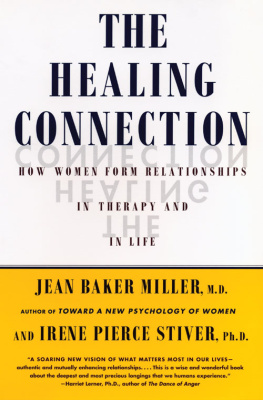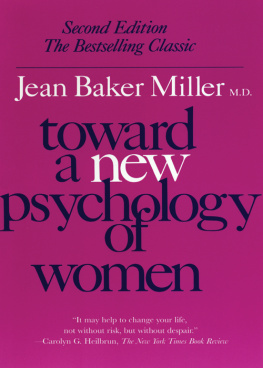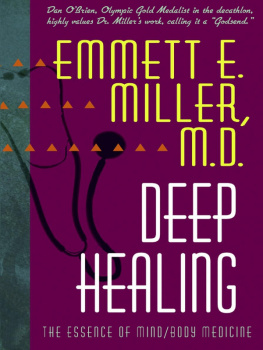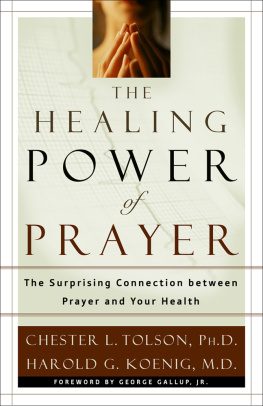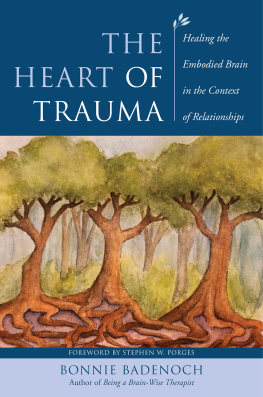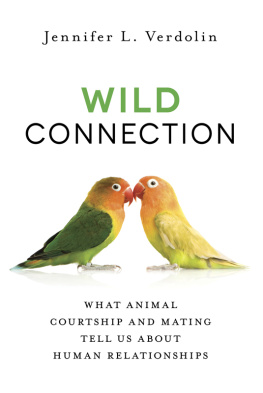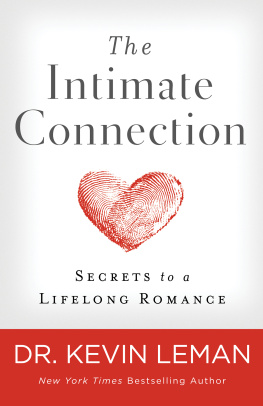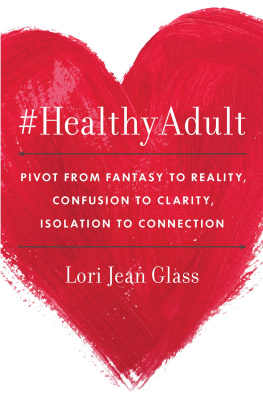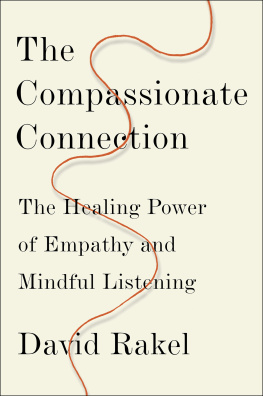Also by Jean Baker Miller and Irene Pierce Stiver:
WOMENS GROWTH IN CONNECTION
(written with Judith Jordan, Alexandra Kaplan, and Janet S. Surrey)
Also by Jean Baker Miller:
TOWARD A NEW PSYCHOLOGY OF WOMEN
PSYCHOANALYSIS AND WOMEN (editor)

To
Ray and Lynne
Mike, Ned, Jon, Myriam, and Jake
CONTENTS
PART ONE
CONNECTIONS
PART TWO
DISCONNECTIONS
PART THREE
PSYCHOTHERAPY
PART FOUR
COMMUNITY
11. From Self to Community in Therapy, in Life
ACKNOWLEDGMENTS
With great warmth and affection we express our special appreciation to Judith Jordan and Janet Surrey. We four are members of a core group that has been meeting for twenty years to work on the development of a better understanding of the psychology of womenand ultimately, of all human beings.
The ideas presented here grow out of our common endeavors and represent just one branch of the basic work we have done together over the years. It has been a unique experience, full of zest, hard work, and fun, to work closely with such friends and colleagues. We are deeply grateful to them. We will describe their work further in the introduction and throughout this book.
In addition to this core group, we want to thank a larger number of students, supervisees, and colleagues from whom we have learned. In recent years they have included Diane Becker, Steve Bergman, Mary Collins, Robin Cook-Nobles, Mimi Dohan, Catherine Dooley, Susan Eaton, Natalie Eldridge, Denise Elliott, Niki Fedele, Susan Filene, Joyce Fletcher, Nancy Gleason, Elizabeth Harrington, Maureen Harvey, Judith Herman, Andrea Johnson, Yvonne Jenkins, Kay Kahn, Alexandra Kaplan, Lori Kaplowitz, Carol Kauffman, Marisa Laviola, Lynne Lieberman, Diane Littlefield, Jane MacDonald, Julie Mencher, Susan Miller, Marsha Pravda Mirkin, Pamela Peck, Wendy Rosen, Barbara Rosenthal, Julie Ross, Georgia Sassen, Barbara Schwartz, Suzanne Slater, Carolyn Swift, Beverly Daniel Tatum, Maureen Walker, and Laura Woodburn. Weve also learned from women all over the country (and some in other countries) who have attended sessions where we have spoken and who continue to interact with us. Many have established study groups, which has led to their conducting teaching conferences in their areas, developing research projects, and exploring the wider applications of our work.
Our close colleagues Judith Jordan and Janet Surrey have read this manuscript and made major contributions to it, as they have to all of our work together. For a long time now, Carol Gilligans work has played a special part in our endeavors. We have been traveling a similar although not identical road, pursuing new conceptions and questioning old formulations. We believe this work leads to a whole new view of psychology and opens up an enlarged vision of all of life. In doing so, it also offers a new basis for work in many fields beyond psychology. Carol and we have found great pleasure in discovering that our work often confirmed each others thinking. Further, we are grateful to her for reading a large part of this manuscript and giving us her insightful suggestions. Christina Robb has also read large portions of this manuscript and has been a most enthusiastic and astute advisor. Her depth of understanding and knowledge has been a valuable gift to us.
We owe a particular and unique debt to our patients. Many of them are represented in this book. In all instances they have been heavily disguised to protect their privacy, but we hope that we have been able to portray the essence of our work together. They have made it possible for us to create with them the growth-fostering new experience that psychotherapy can be.
We are grateful to the Stone Center for Developmental Services and Studies at Wellesley College, now a part of the Wellesley Centers for Women, and to the centers staff and overseers, with whom we have worked for many years. Several of the centers directors have been most supportive of our work, including Carolyn Swift, Maud Chaplin, Cynthia Garca Coll, Joanne Murray, and Susan Bailey. Janet Rubenstein has been a devoted assistant and has helped to carry forward many programs and projects.
We have also relied on a great deal of help from several writers and editors. MaryAnn Lash has been with us throughout; her encouragement and her talent have sustained us and have had a profound effect on the whole book. We are very grateful to Lauren Bryant, who advised us on the book and also rewrote a significant part of the first chapter. Marya E. Vant Hul of Beacon Press has been a delight to work with. She has been most encouraging and empowering. Her excellent ideas and critique have improved this book immensely. Moreover, she helped to translate this book into much greater clarity. With great energy, our agent, Anne Borchardt, has applied her extensive literary expertise to bringing this book into existence.
We count ourselves as incredibly fortunate to have husbands who take pleasure in our workS. M. (Mike) Miller and Ray Stiver. Characteristically, they have enjoyed the exploration of our ideas with us. They too have read this manuscript and given us invaluable comments and suggestions, and they have been supportive and dedicated beyond measure in many other ways, large and small; they have enriched our lives with their warmth, generosity, and good humor. Other people who have brought us help and joy, along with good ideas, are Irenes niece, Lynne Lieberman; Jeans sons, Edward D. (Ned) and Jon; and Jeans daughter-in-law, Myriam Barenbaum, and grandson, Jake.
INTRODUCTION

During the late sixties and early seventies, feminist writers began to show that traditional psychodynamic theories and forms of practice neglected or misunderstood many aspects of womens experience. Their work inspired us and our colleagues Judith Jordan and Janet Surrey to think about these issues more systematically. We began in 1977 to meet in our Monday Night Group and this book is a product of that group. It emerges out of the exchanges we have created together. At times our ideas flowed from the interactions among us, so that it would be inappropriate to say that any idea belonged to any one person; each idea became enlarged and transformed in interchange, was not what it was when it began, and is truly everyones creation. Thus, this book represents all of us.
We are all clinicians with many years experience who came together to try to better understand womens psychological development, the problems women encounter, and what to do about them. Our work grows out of this clinical background; all of us were trained in, and practiced, one or another form of psychodynamic psychotherapy.
We began by closely examining the experience of the women with whom we work. The more we examined, the more we found that traditional explanations could not suffice; and the more these explanations did not suffice, the more we realized that certain of the basic premises behind them could not hold up.
All psychological formulations rest on an underlying theory and set of assumptions although these are not always made explicit. This holds true for both popular and professional literature. When the underlying theory is not explicit, most formulations tend to accept the prevalent thinking in the field, which in turn usually reflects dominant cultural assumptions. Underlying theory can be difficult to identify; it is ubiquitous and, like all cultural assumptions, can seem natural or self-evident.

